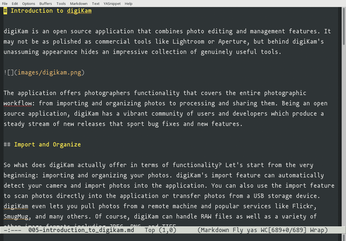Emacs for writers
Text Mode

With the pointers and useful tips in this article, you can turn Emacs into a powerful writing environment.
Emacs can be anything you want it to be: a coding environment, an outliner, a task manager, and everything in between. You can transform this versatile text editor into a tool for writing articles, drafting blog posts, and penning your next great novel (Figure 1). As is often the case, the exact Emacs configuration and customizations depend on your specific needs and usage scenarios, but there are several tweaks and plugins you might find useful no matter what writing tasks you plan.
Configuring and Extending Emacs
The .emacs file in your home directory specifies Emacs' default behavior and configures a wide range of settings. The example configuration in Listing 1 contains several useful commands and options. The default monospaced font and line spacing make regular text difficult to read, and the set-default-font and setq-default line-spacing expressions let you specify the desired font (it must be installed on your system), font size, and line spacing. In this case, Emacs is set to use the Mononoki font at the 17pt size.
[...]
Buy this article as PDF
(incl. VAT)
Buy Linux Magazine
Subscribe to our Linux Newsletters
Find Linux and Open Source Jobs
Subscribe to our ADMIN Newsletters
Support Our Work
Linux Magazine content is made possible with support from readers like you. Please consider contributing when you’ve found an article to be beneficial.

News
-
Parrot OS Switches to KDE Plasma Desktop
Yet another distro is making the move to the KDE Plasma desktop.
-
TUXEDO Announces Gemini 17
TUXEDO Computers has released the fourth generation of its Gemini laptop with plenty of updates.
-
Two New Distros Adopt Enlightenment
MX Moksha and AV Linux 25 join ranks with Bodhi Linux and embrace the Enlightenment desktop.
-
Solus Linux 4.8 Removes Python 2
Solus Linux 4.8 has been released with the latest Linux kernel, updated desktops, and a key removal.
-
Zorin OS 18 Hits over a Million Downloads
If you doubt Linux isn't gaining popularity, you only have to look at Zorin OS's download numbers.
-
TUXEDO Computers Scraps Snapdragon X1E-Based Laptop
Due to issues with a Snapdragon CPU, TUXEDO Computers has cancelled its plans to release a laptop based on this elite hardware.
-
Debian Unleashes Debian Libre Live
Debian Libre Live keeps your machine free of proprietary software.
-
Valve Announces Pending Release of Steam Machine
Shout it to the heavens: Steam Machine, powered by Linux, is set to arrive in 2026.
-
Happy Birthday, ADMIN Magazine!
ADMIN is celebrating its 15th anniversary with issue #90.
-
Another Linux Malware Discovered
Russian hackers use Hyper-V to hide malware within Linux virtual machines.


